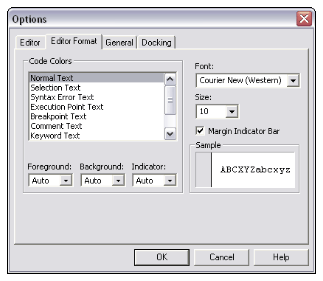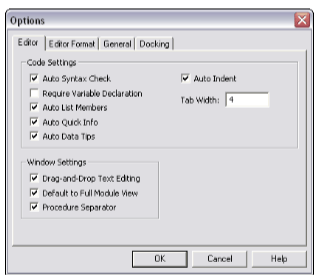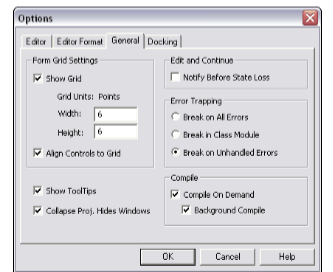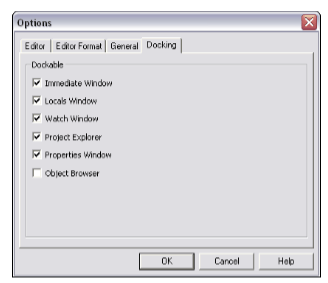
Customizing the VBA Environment
If you’re serious about becoming an Excel programmer, you’ll spend a lot of time with VBA modules
on your screen. To help make things as comfortable as possible, the VBE provides quite a few cus-
tomization options.
When the VBE is active, choose Tools➜Options. You’ll see a dialog box with four tabs: Editor, Editor
Format, General, and Docking. Take a moment to explore some of the options found on each tab.
The Editor tab
Figure 1-12 shows the options accessed by clicking the Editor tab of the Options dialog box. Use the
option in the Editor tab to control how certain things work in the VBE.

Figure 1-12: The Editor tab in the Options dialog box.
The Auto Syntax Check option
The Auto Syntax Check setting determines whether the VBE pops up a dialog box if it discovers a
syntax error while you’re entering your VBA code. The dialog box tells roughly what the problem is.
If you don’t choose this setting, VBE flags syntax errors by displaying them in a different color from
the rest of the code, and you don’t have to deal with any dialog boxes popping up on your screen.
The Require Variable Declaration option
If the Require Variable Declaration option is set, VBE inserts the following statement at the beginning
of each new VBA module you insert:
Option Explicit
Changing this setting affects only new modules, not existing modules. If this statement appears in
your module, you must explicitly define each variable you use. Using a Dim statement is one way to
declare variables.
The Auto List Members option
If the Auto List Members option is set, VBE provides some help when you’re entering your VBA code.
It displays a list that would logically complete the statement you’re typing. This is one of the best fea-
tures of the VBE.
The Auto Quick Info option
If the Auto Quick Info option is selected, VBE displays information about functions and their arguments
as you type. This is similar to the way Excel lists the arguments for a function as you start typing a new
formula.
The Auto Data Tips option
If the Auto Data Tips option is set, VBE displays the value of the variable over which your cursor is
placed when you’re debugging code. This is turned on by default and often quite useful. You have
no reason to turn this option off.
The Auto Indent setting
The Auto Indent setting determines whether VBE automatically indents each new line of code the
same as the previous line. I’m big on using indentations in my code, so I keep this option on.
The VBE’s Edit toolbar (which is hidden by default) contains two useful buttons: Indent and Outdent.
These buttons let you quickly indent or “unindent” a block of code. Select the code and click one of these
buttons to change the block’s indenting.
The Drag-and-Drop Text Editing option
The Drag-and-Drop Text Editing option, when enabled, lets you copy and move text by dragging and
dropping with your mouse. I keep this option turned on, but I never use it. I prefer to copy and move by
using the keyboard.
The Default to Full Module View option
The Default to Full Module View option sets the default state for new modules. (It doesn’t affect exist-
ing modules.) If set, procedures in the Code window appear as a single scrollable list. If this option is
turned off, you can see only one procedure at a time. I keep this option turned on.
The Procedure Separator option
When the Procedure Separator option is turned on, separator bars appear at the end of each proce-
dure in a Code window. I like the idea of separator bars, so I keep this option turned on.
The Editor Format tab
Figure 1-13 shows the Editor Format tab of the Options dialog box. With this tab, you can customize
the way the VBE looks.

Figure 1-13: Change the VBE’s looks with the Editor Format tab.
The Code Colors option
The Code Colors option lets you set the text color and background color displayed for various elements of
VBA code. This is largely a matter of personal preference. Personally, I find the default colors to be just fine.
But for a change of scenery, I occasionally play around with these settings.
The Font option
The Font option lets you select the font that’s used in your VBA modules. For best results, stick with a
fixed-width font such as Courier New. In a fixed-width font, all characters are exactly the same width.
This makes your code more readable because the characters are nicely aligned vertically and you can
easily distinguish multiple spaces (which is sometimes useful).
The Size setting
The Size setting specifies the point size of the font in the VBA modules. This setting is a matter of
personal preference determined by your video display resolution and how good your eyesight is.
The Margin Indicator Bar option
This option controls the display of the vertical margin indicator bar in your modules. You should keep
this turned on; otherwise, you won’t be able to see the helpful graphical indicators when you’re
debugging your code.
The General tab
Figure 1-14 shows the options available under the General tab in the Options dialog box. In almost
every case, the default settings are just fine.
The most important setting on the General tab is Error Trapping. We strongly suggest that you use the
Break on Unhandled Errors setting. This ensures Excel can identify errors as you type your code.

Figure 1-14: The General tab of the Options dialog box.
The Docking tab
Figure 1-15 shows the Docking tab. These options determine how the various windows in the VBE
behave. When a window is docked, it is fixed in place along one of the edges of the VBE program
window. This makes it much easier to identify and locate a particular window. If you turn off all
docking, you have a big, confusing mess of windows. Generally, the default settings work fine.

Figure 1-15: The Docking tab of the Options dialog box.





